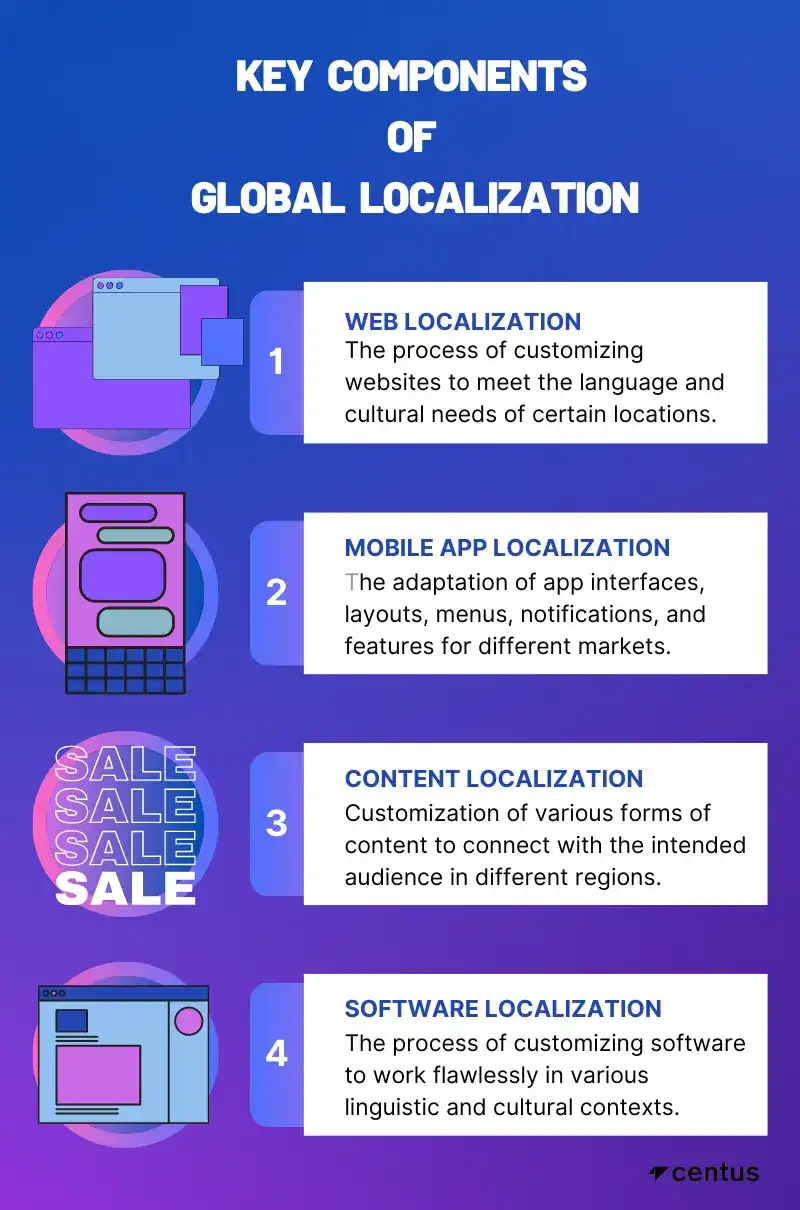What is Global Localization: Principles & Strategy
As the world becomes more connected, global business opportunities continue to expand. To stay competitive, companies must adapt their products, services, and content to match the expectations and needs of international audiences.
This is where global localization plays a critical role.
In this article, we’ll break down what global localization means, highlight its core components, share real-world examples, and walk you through building an effective global localization strategy.
Pro tip: A professional localization platform like Centus simplifies global localization. Automate translations, manage terminology, reuse content with translation memory, apply QA checks, and coordinate teams—all in one place for faster, more accurate results.
What Is Global Localization?
Global localization is the process of adapting your products, services, and content to meet the linguistic, cultural, functional, and legal expectations of specific local markets. It’s more than translation—it’s about shaping the entire user experience so it feels natural and relevant to people in each region.
By understanding and respecting local norms, businesses can create experiences that feel native to the target audience. This not only increases engagement but also builds trust and long-term customer relationships across diverse markets.
Key Components of Global Localization

To build an effective global localization strategy, you need to focus on several essential areas. Each component plays a specific role in ensuring that your products, services, and communications feel natural and relevant in every market you serve.
Web Localization
Web localization is the process of adapting a website to match the language, culture, and expectations of users in a specific region. It involves more than just translation—it includes updating visuals, formatting dates and currencies, and ensuring compliance with local laws.
Done right, web localization creates a seamless experience for visitors. It allows them to browse, engage, and convert in their native language—without friction.
Mobile App Localization
Mobile app localization involves adapting all aspects of your app—from interface text and menus to notifications and features—for different languages and markets. This may also require layout adjustments or functional tweaks based on regional norms.
By localizing your app, you remove language barriers, improve usability, and increase user adoption in new markets.
Content Localization
Content localization means tailoring various forms of content to align with local cultural, linguistic, and contextual norms. This applies to everything from marketing copy and product descriptions to legal terms, help center articles, and multimedia assets.
Unlike simple content translation, localization considers idioms, cultural references, tone, and formatting. The goal is to ensure your message resonates just as clearly across all audiences.
Software Localization
Software localization is the process of preparing software products for use in different languages and regions. This includes translating UI text, adapting date/time formats, localizing documentation, and ensuring functionality fits regional standards.
Software that feels intuitive to one audience may confuse another. Localizing your software removes those barriers and makes the product accessible and relevant for users worldwide.
What Is a Global Localization Strategy?
A global localization strategy is a structured plan that enables businesses to adapt their products, services, and marketing for specific regions, ensuring cultural, linguistic, and functional relevance. Developing such a strategy requires a deep understanding of local customs, user behavior, language, and market expectations.
Here’s what defines an effective global localization strategy:
- It ensures content and user experiences are not only linguistically accurate but culturally aligned with the target market.
- It goes beyond translation, adapting design, user interface, functionality, and tone to match local expectations.
- Successful implementation requires cross-functional collaboration and alignment across departments.
- It accounts for language, cultural norms, legal requirements, and technical constraints to tailor the product for local use.
- Visual elements—such as symbols, color schemes, and images—may be adapted to reflect regional preferences.
- Functional adjustments are sometimes needed to meet regulatory or usability standards in different markets.
4 Key Benefits of a Global Localization Strategy
A well-executed localization strategy delivers more than just accurate translations. Here’s how it creates real business value:
1. Aligning With Local Markets and Cultures
Every market has its own language, customs, and expectations. Localization lets you tailor your offering to fit these specifics—building trust, improving clarity, and showing your audience that you understand their world.
By aligning content and functionality with local norms, you create experiences that feel native—not foreign.
2. Enhancing User Experience and Customer Satisfaction
When users can navigate your product easily and understand your messaging without effort, satisfaction increases. Localization helps remove friction, making your offering intuitive and accessible in any market.
This leads to higher engagement, better retention, and more positive user outcomes.
3. Strengthening Brand Perception and Trust
Taking the time to localize your product signals commitment. It tells international users that they matter—and that you’ve invested in making your brand relevant to them.
That kind of attention to detail builds trust and enhances your brand image in every market you serve.
4. Opening Up New Markets
Localization is often the first step toward real global expansion. By removing language barriers, adapting to regulations, and respecting cultural norms, you make it possible to enter new regions confidently.
This opens up growth opportunities, drives global revenue, and positions your company to compete as a true international player.
How to Develop a Global Localization Strategy in 4 Steps
Expanding into international markets requires more than translating content. A successful global localization strategy starts with careful planning and ends with efficient execution. Follow these four steps to build a strategy that works.
Step 1 – Research Target Markets and Languages
Start with a detailed analysis of each target market. Study consumer behavior, cultural values, language preferences, and how people in those regions interact with digital products.
Identify the primary languages spoken and assess how much localization each language will require. Some markets may only need minor adjustments; others may require full adaptation of content and functionality.
Step 2 – Define Your Localization Goals and Priorities
Set clear objectives for your localization efforts. Rank markets based on potential ROI, cultural fit, and relevance to your business goals.
Decide what needs localization: is it your website, mobile app, marketing content, support materials, or software interface? Build a roadmap that prioritizes what gets localized and when.
Step 3 – Choose the Right Localization Tools
Leverage technology to scale localization efficiently. Look into translation management systems, localization platforms, and multilingual CMS options that align with your workflow.
Consider key factors like scalability, integration with your tech stack, ease of collaboration, and support for automation features like translation memory and glossaries.
Step 4 – Build a Structured Localization Workflow
Map out the full localization process—from content creation and translation to quality checks and publishing.
Assign clear responsibilities to team members, whether in-house or external. Set up effective communication and feedback loops between translators, developers, project managers, and reviewers.
A well-documented process helps maintain consistency, reduce delays, and ensure smooth execution across markets.
Perform Global Localization with Centus
Building and executing a global localization strategy can be complex. To simplify the process, use a dedicated localization platform like Centus—a suite built to support teams managing multilingual content at scale.
Below are key features that make Centus effective for global localization:
-
Wide Language Support
Localize your product or service for virtually any market with support for dozens of language pairs. -
Translation Memory
Centus stores previously translated segments, reducing repetition and improving consistency. This also lowers costs by reusing approved translations. -
Quality Assurance (QA)
Built-in QA checks help catch errors early and ensure accuracy across all languages. -
Project Management Tools
Stay on top of deadlines, assignments, and workflows with integrated task tracking and team coordination features. -
Reporting and Analytics
Monitor translation quality, delivery timelines, and costs with reporting tools that give you insight into every stage of the project. -
Collaborative Workspace
Centus makes it easy for teams to collaborate in real time. Share files, add comments, edit translations, and resolve issues within a centralized platform. -
Tool Integrations
Centus integrates with popular platforms like CMSs, Figma, and Jira, streamlining import/export processes and fitting into your existing workflow. -
Scalability
Whether you're localizing for one region or many, Centus grows with you—easily adding more users, languages, and projects as needed. -
Data Security
Centus follows strict security protocols to keep your content protected throughout the localization lifecycle.
By using Centus, you can reduce manual overhead, improve translation quality, and accelerate your global rollout—all while keeping your localization efforts aligned and efficient. Learn more
Get the week's best content!
By subscribing, you are agreeing to have your personal information managed in accordance with the terms of Centus Privacy Policy ->
Keep learning

13 min. read
Building a Multidomestic Strategy with Examples
11 min. read
What Is Localization? A Comprehensive Overview
11 min. read
How to Build a Localization Strategy and Do it Right
6 min. read
Internationalization and Globalization: What’s the Difference Between?
13 min. read
Global Expansion Strategy Explained with Examples
15 min. read